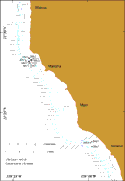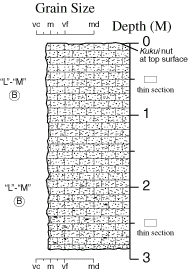
Other info:

U.S. Geological Survey
Open-File Report 03-441
Home > data > vibracores > sketches, descriptions & photographs > leeward coast
 |
Other info: |
|
Vibracore 17V1, Leeward coast Uniform succession of vaguely-laminated to massive (bioturbated), medium-to coarse-grained, algal/coral/foraminiferal carbonate sand: massive appearing (no obvious sedimentary structures) owing probably to extensive bioturbation; light olive to olive gray (5Y6/1-4/1); moderate sorting; sand size clasts subrounded to rounded; composed mainly of a mix of calcareous algae (27.0-34.0%) coral fragments (19.5-27.0%) and foraminifera (15.0-21.0%) with abundant carbonate rock fragments (9.0-11.5%) and volcanic rock fragments (5.5-8.5%); minor echinoid fragments (2.0-2.5%), mollusks (3.0%) and Halimeda (0.5-1.0%). |
Click either image for larger views (46 kb)  |
 |
|
Vibracore 19V1, Leeward coast Uniform succession of vaguely-laminated to bioturbated, fine- to medium-grained, foraminiferal/algal/coral carbonate sand: massive appearing owing probably to extensive bioturbation; light olive to olive gray (5Y6/1-4/1); moderate sorting (2-4% scattered shell fragments; 2-3 mm diameter); sand size clasts subangular to rounded; composed mainly of a mix of foraminifera (30.5%), calcareous algae (25.5%), coral fragments (23.5%); common volcanic rock fragments (5.5%); minor carbonate rock fragments (3.0%) and echinoid fragments (3.0%). Massive-appearing (bioturbated), medium- to coarse-grained, algal/coral/foraminiferal carbonate sand: light olive to olive gray (5Y6/1-4/1); poor sorting (4-6% scattered shell fragments; 2-5 mm diameter); sand size clasts subrounded to rounded; composed mainly of a mix of calcareous algae (38.5%), coral fragments (24.5%) and foraminifera (10.5%), with abundant volcanic rock fragments (9.0%) and carbonate rock fragments (9.0%); note distinct specimens of the small solitary coral Cycloseris fragilis. |
Click either image for larger views (105 kb) |
|
Vibracore 20V1, Leeward coast Uniform succession of vaguely-laminated to bioturbated, medium-grained, algal/coral/foraminiferal carbonate sand: massive appearing (no obvious sedimentary structures) owing probably to extensive bioturbation; light olive to olive gray (5Y6/1-4/1); moderate sorting (1-3% scattered shell fragments); sand size clasts subangular to rounded; composed mainly of a mix of calcareous algae (37.0-38.5%), coral fragments (27.0-31.0%) and foraminifera (20.0-22.5%) with common carbonate rock fragments (3.0-4.5%) and volcanic rock fragments (2.0-4.5%); minor echinoid fragments (1.5-4.0%), mollusks (0.5-3.0%) and Halimeda (0.5-1.5%). |
Click either image for larger views (105 kb) |
|
Vibracore 21V1, Leeward coast Uniform succession of massive-appearing, bioturbated, fine- to medium-grained, algal/coral/foraminiferal carbonate sand: massive appearing (no obvious sedimentary structures) owing probably to extensive bioturbation; olive gray to medium gray (5Y4/1 to N4); moderate sorting (2-5% scattered shell fragments; 2-5 mm); sand size clasts subangular to rounded; composed mainly of a mix of calcareous algae (29.0-38.5%), coral fragments (28.5-36.5%) and foraminifera (14.5-18.0%); common Halimeda (3.5-6.0) and carbonate rock fragments (5.5%); minor volcanic rock fragments (1.5-2.0%) and echinoid fragments (1.5-2.5%); minor distinct specimens of the solitary coral Cycloseris fragilis. |
Click either image for larger views (110 kb) |
|
Vibracore 22V1, Leeward coast Uniform succession of burrowed to bioturbated, fine- to coarse-grained, coral/algal/foraminiferal carbonate sand: massive-appearing (burrowed-mottled) owing to extensive bioturbation; olive gray (5Y4/1) mottled locally pale yellowish-brown (10YR6/2); moderate sorting; sand size clasts subangular to rounded; composed mainly of a mix of coral fragments (37.5%), calcareous algae (30.0%) and foraminifera (18.5%) with common volcanic rock fragments (6.0%) and minor Halimeda (1.5%). Uniform succession of burrowed to bioturbated, very fine- to coarse-grained, volcaniclastic, coral/algal/foraminiferal carbonate sand: massive-appearing (burrowed-mottled) owing to extensive bioturbation; olive gray (5Y4/1) burrow-mottled to pale yellowish brown (10YR6/2); poor sorting; sand size clasts angular to rounded; composed mainly of a mix of coral fragments (42.5%), calcareous algae (30.0%) and foraminifera (7.0%) with abundant volcanic rock fragments (13.5%). |
Click either image for larger views (96 kb) |
|
Vibracore 24V1, Leeward coast Uniform succession of massive-appearing (bioturbated), very fine- to medium-grained, algal/coral/foraminiferal carbonate sand: massive appearing (no obvious sedimentary structures) owing to extensive bioturbation; yellowish gray (5Y8/1) to light olive gray (5Y6/1) above; well sorted (2-5% scattered shell fragments); sand size clasts angular to subrounded; composed mainly of a mix of calcareous algae (26.0-37.0%) coral fragments (22.5-28.0%) and foraminifera (14.5-25.0%); abundant Halimeda (7.5-15.0%), common carbonate rock fragments (2.5-3.5%); minor echinoid fragments (2.5-3.0%). |
Click either image for larger views (76 kb) |
|
Vibracores 25V1 and 26V1, Leeward (west) coast Vibracore 25V1 Vibracore 26V1 |
Click either image for larger views (97 kb) |
|
Top of page
|
http://geopubs.wr.usgs.gov/open-file/of03-441/data/vibracore/descriptions/leeward.html
For more information, please contact: Monty Hampton
Pages created and maintained by Laura Zink Torresan
last modified 15 December 2003 (cad)
USGS Privacy Statement | Disclaimer | Feedback | Accessibility
Department of the Interior U.S. Geological Survey Geologic Division
Coastal & Marine Geology Program Western Region Coastal & Marine Geology Team